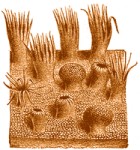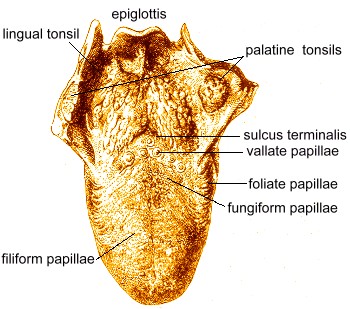  Your tongue is actually a collection of muscles; proportional to their size, they're the strongest muscles in your body. Four pairs of muscles lie inside the tongue, running down its full length. The tongue performs many functions in your mouth. The flexible front part can move to different spots, helping you to form different sounds as you speak. The tongue also helps move food around so that the teeth can chew it, and the back part of the tongue then helps push chewed food, wet with saliva, into the esophagus on its way to the stomach. Underneath the tongue is a membrane that connects the tongue to the bottom of the mouth, preventing it from being swallowed.  The top of the tongue is covered with tiny bumps called papillae (picture at left). Papillae give the tongue a rough surface so it can push food around while you chew. Papillae also contain the taste buds, which allow you to distinguish flavours. You were born with about 10,000 taste buds, but they begin to die as you get older; elderly people may have only 5,000. The top of the tongue is covered with tiny bumps called papillae (picture at left). Papillae give the tongue a rough surface so it can push food around while you chew. Papillae also contain the taste buds, which allow you to distinguish flavours. You were born with about 10,000 taste buds, but they begin to die as you get older; elderly people may have only 5,000.
Each taste bud is made up of cells containing tiny, sensitive hairs called microvilli which send messages to the brain, where the signals are interpreted as a taste. Taste buds can recognize four distinct tastes: sweet, bitter, salty and sour. Foods can make your taste buds less sensitive, especially if they're cold. Frozen juice doesn't taste as sweet as the same juice in liquid form. The taste buds are helped out by your nose, which actually contributes to your sense of taste by adding odour signals to those sent to the brain by your tongue. You can verify this by holding your nose while eating something; the taste sensations will be greatly diminished. This is also the reason why you can't taste your food when you have a cold ... your sense of smell isn't working very well because of the nasal congestion.  Your tongue also helps your body to fight infections. The back part of the tongue contains the lingual tonsil, which helps filter germs; together with the palatine tonsils (two masses of tissue on either side of the tongue) and the adenoids, these help fight infections throughout your body. (When you have tonsilitis, it's the palatine tonsils that are affected).
Your tongue also helps your body to fight infections. The back part of the tongue contains the lingual tonsil, which helps filter germs; together with the palatine tonsils (two masses of tissue on either side of the tongue) and the adenoids, these help fight infections throughout your body. (When you have tonsilitis, it's the palatine tonsils that are affected).
The back and front parts of the tongue are separated by a V-shaped groove called the sulcus terminalis. It's on the front part of the tongue where the papillae are. There are four types of papillae, and all but one contain taste buds. These are the filiform (thread-shape), fungiform (mushroom-shape), foliate (leaf-shape), and vallate (ringed-circle) papillae. All papillae except the filiform (whose function is solely to help grip food) have taste buds on their surfaces. Just in front of the sulcus terminalis are the largest of the taste-bud papillae, the vallate papillae; there are between 8 and 14 of them.  Stephen Taylor holds the world record for the world's longest tongue, which measures 9.4 centimeters from the tip to the center of his top lip. He is able to insert his tongue into his nostrils! Stephen Taylor holds the world record for the world's longest tongue, which measures 9.4 centimeters from the tip to the center of his top lip. He is able to insert his tongue into his nostrils!
In animals, the tongue is often rougher, and may be used to clean the fur and body. A dog's tongue also acts as a heat regulator; as a dog becomes more active, the size of its tongue will increase (because of increased blood flow) and hang out of its mouth. This allows evaporation to cool the tongue and the blood inside it; the cooled blood returns to the body to provide a cooling effect. |